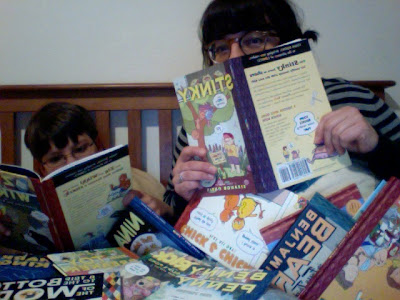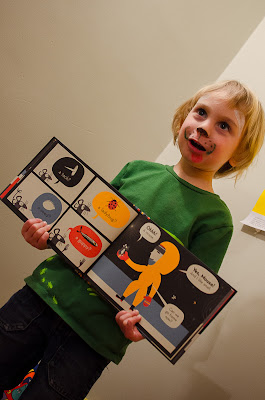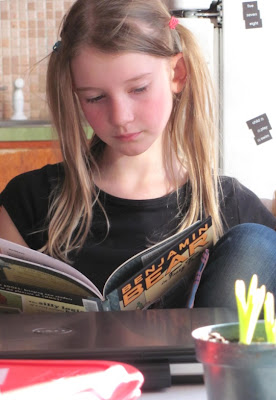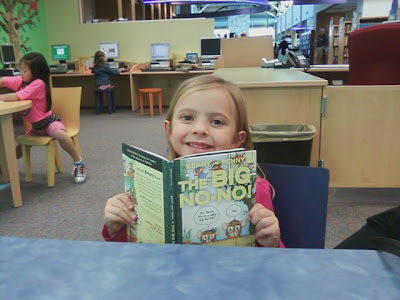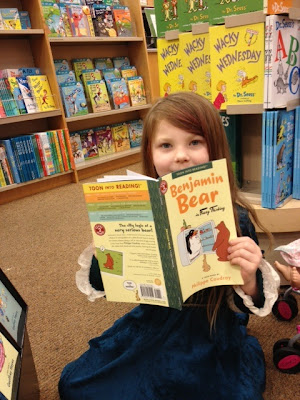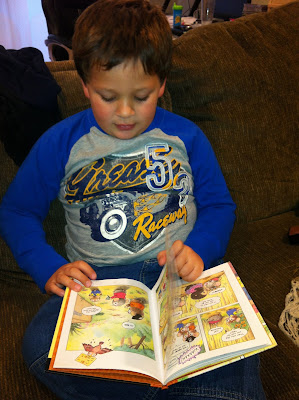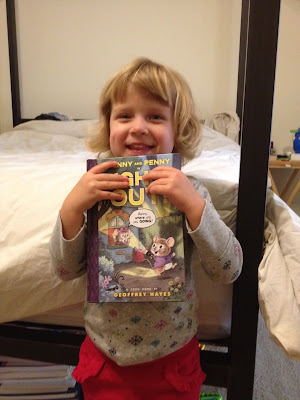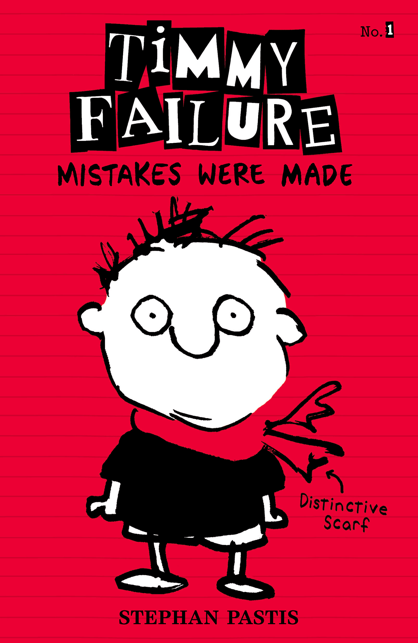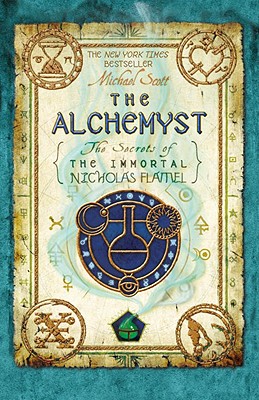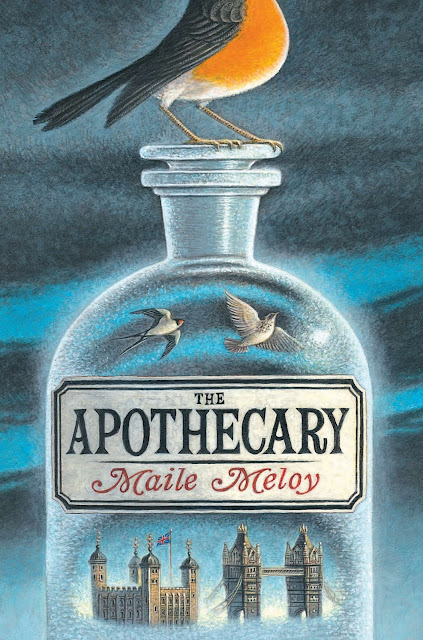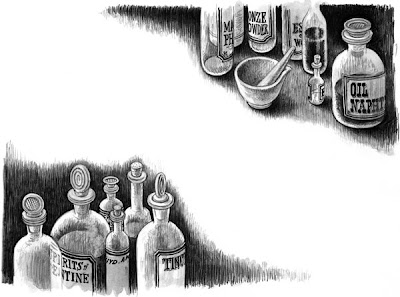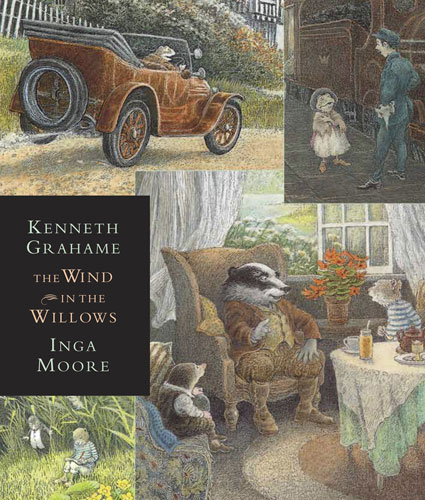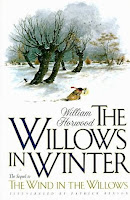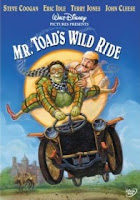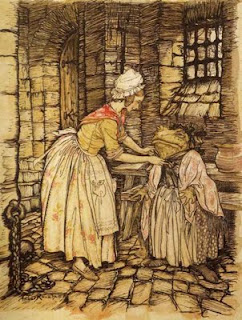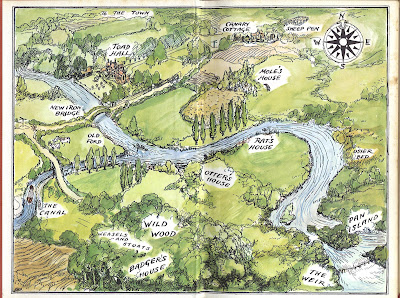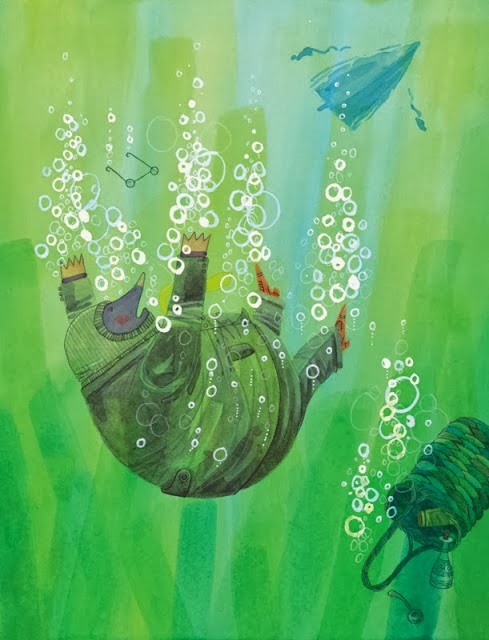Where you can find the best book at the right reading level and spark (or fuel) a life long love of reading in your kids!
2.26.2013
2.25.2013
Timmy Failure: Mistakes Were Made, by Stephan Pastis, 294 pp, RL 4
Let's just get this 1,500 lb polar bear in the room out of the way right now: Yes. Timmy Failure: Mistakes Were Made by Stephan Pastis does join a long line of notebook-novel-knock-offs that have filled the shelves since the Diary of a Wimpy Kid series by Jeff Kinney debuted in 2007. Yes: I do not really like the Diary of a Wimpy Kid series for a number of reasons and am skeptical of all books that come in its wake. That said, there is one thing that I will be eternally grateful to Jeff Kinney for - making illustrations an acceptable, desirable quality in middle-grade novels - notebook style or otherwise. I am all for the merging of graphic novels and middle grade novels and there are actually a few Notebooks Novels I really love, including Amy Ignatow's Popularity Papers series and Tom Angleberger's Origami Yoda series. The existence of either of which does not seem entirely possible without the huge success of Kinney's books coming before. If nothing else, the immense popularity of the Wimpy Kid series proved to publishers and booksellers that parents are willing to let their children read "books with pictures" at a time in their academic career when it is assumed they should be beyond this type of book. More importantly, it proved that parents are willing to PURCHASE these books, often only available in the pricier hard cover format, and purchase them every year as new additions to the series are relased. And why is it that parents are willing to to this, ultimately? Because kids, especially kids who don't like to read, LOVE this kind of book!
So, why do I like Timmy Failure: Mistakes Were Made so much and Diary of a Wimpy Kid not so much? Both Timmy and Greg are flawed characters. As Pastis, the creator of the syndicated comic strip Pearls Before Swine, said of creating this novel, he started with the question “What makes me laugh?” He found his answer quickly. “What makes me laugh is a character with a huge blind spot,” he says. “I like characters like Ignatius Reilly in A Confederacy of Dunces and Ricky Gervais’s character in The Office. They think one thing about themselves, but the truth is as far from that as it can be. So I began to think about how to put that kind of character in a book for kids.”
 Timmy is most definitely an unreliable narrator with a view of the world as self-centered and skewed as Greg at times. The comparisons end there, for the most part. Timmy and his life are much more like Calvin, of Calvin and Hobbes fame. In fact, like Calvin, Timmy has an animal companion - Total, the 1,500 pound polar bear who came across the Failure's cat dish while wandering in search of food. However, we never see Total in stuffed-toy form as we do Hobbes, leaving the biggest question (one that comes up in almost every review) is Total real or imaginary? My eight-year-old son, who tore this book from my hands the minute he saw it, insists that Total IS real, although Timmy's mother never sees him. Timmy is a self-styled detective and "founder, president and CEO" of Failure, Inc. Timmy gets all the "failure" jokes out of the way right from the start, although there is always room for more. Timmy decides to partner with Total, who initially "displayed a fair degree of diligence and reliability." As it turned out, the "diligence and reliability were a ruse. Something polar bears do." It wasn't until after Timmy agreed to name their agency TOTAL FAILURE, INC (WE WON'T FAIL, DESPITE WHAT THE NAME SAYS.) and took out an add in the yellow pages that he discovered Total wasn't all he appeared.
Timmy is most definitely an unreliable narrator with a view of the world as self-centered and skewed as Greg at times. The comparisons end there, for the most part. Timmy and his life are much more like Calvin, of Calvin and Hobbes fame. In fact, like Calvin, Timmy has an animal companion - Total, the 1,500 pound polar bear who came across the Failure's cat dish while wandering in search of food. However, we never see Total in stuffed-toy form as we do Hobbes, leaving the biggest question (one that comes up in almost every review) is Total real or imaginary? My eight-year-old son, who tore this book from my hands the minute he saw it, insists that Total IS real, although Timmy's mother never sees him. Timmy is a self-styled detective and "founder, president and CEO" of Failure, Inc. Timmy gets all the "failure" jokes out of the way right from the start, although there is always room for more. Timmy decides to partner with Total, who initially "displayed a fair degree of diligence and reliability." As it turned out, the "diligence and reliability were a ruse. Something polar bears do." It wasn't until after Timmy agreed to name their agency TOTAL FAILURE, INC (WE WON'T FAIL, DESPITE WHAT THE NAME SAYS.) and took out an add in the yellow pages that he discovered Total wasn't all he appeared.
 Like Ricky Gervais's character in The Office, Timmy Failure's blind spot, combined with the conviction that TOTAL FAILURE, INC. is just one case away from becoming a Fortune 500 company, can be painful to watch. Pastis lightens this with humor, mostly from Total but Pastis pretty much stacks the deck in favor of the absurd. My favorite part was a visit to Molly Moskin's house and and encounter with her cat, Señor Burrito, who took every opportunity to put her paw (yes, Señor Burrito is a female) into Timmy's tea when he turned his head away. Also, Timmy's mom has a Segway that she won in a raffle. She likes to take it around the block a few times in the evening to unwind after a stressful day at work at the Stationary Store as well as the stress of single-parenting Timmy, who uses her closet as an office and teleconferences with her (at dinner) to counsel her to remove her clothes and shoes from his office. Timmy likes to use the Segway to get to cases, although this eventually results in the disappearance of the Segway and the worst thing possible - tears from his mom. Adults in the book, because they are seen from Timmy's perspective, are at best a future employee (his mom) at worst a smelly old man who leans forward like he has a sack of potatoes tied to his hear (Mr Crocus, his teacher.) The librarian, Flo, looks like he's in a motorcycle gang but reads Emily Dickinson and the yard duty lady, Dondi Sweetwater, encourages Timmy to play with the other kids instead of sitting by the fence everyday and gives him Rice Krispy Treats for his friend that she never sees. Timmy sits by the fence because Total is not allowed on campus (discrimination) and Timmy slips him the Rice Krispy Treats, which he is bonkers for. Then there is Crispin Flavius, Timmy's mom's new boyfriend who thinks it's ok to let Timmy steer his Cadillac from time to time with disastrous results. The negative depiction of the adults in Timmy Failure: Mistakes Were Made is more along the lines of Phineas and Ferb (which can be a pretty smart, creative funny show at times, I must admit) in terms of their obtuseness and occasional inanities. Timmy never says anything outright insulting or malicious to or about the adults. He saves his snark for Rollo Tookus, his rotund, idiot best friend who wants to go to "Stanfurd"(Timmy's spelling.) Pastis makes a point to prove what an unreliable narrator Timmy is by having Timmy note (without even a sliver or irony) that Rollo has a 4.6 GPA, studies and has a tutor and is clearly an ignoramus. Timmy's nemesis, someone who remains behind an obscuring black rectangle for the first part of the book because Timmy refuses to speak of her, is Corinna Corinna (anyone know that song?) who's worst offense is that she is has a successful detective agency and solves cases quickly and with humility. When Timmy sneaks into her backpack and readers Corinna's diary, the reader learns that she lives with her Nanny and father, who seems to be away at work most of the time, although Timmy skews this information to his own perspective. Her diary also reveals the solution to a case Timmy is still trying to crack but, being Timmy he misses the information completely, instead slapping his commentary by way of sticky notes, on the pages of her diary.
Like Ricky Gervais's character in The Office, Timmy Failure's blind spot, combined with the conviction that TOTAL FAILURE, INC. is just one case away from becoming a Fortune 500 company, can be painful to watch. Pastis lightens this with humor, mostly from Total but Pastis pretty much stacks the deck in favor of the absurd. My favorite part was a visit to Molly Moskin's house and and encounter with her cat, Señor Burrito, who took every opportunity to put her paw (yes, Señor Burrito is a female) into Timmy's tea when he turned his head away. Also, Timmy's mom has a Segway that she won in a raffle. She likes to take it around the block a few times in the evening to unwind after a stressful day at work at the Stationary Store as well as the stress of single-parenting Timmy, who uses her closet as an office and teleconferences with her (at dinner) to counsel her to remove her clothes and shoes from his office. Timmy likes to use the Segway to get to cases, although this eventually results in the disappearance of the Segway and the worst thing possible - tears from his mom. Adults in the book, because they are seen from Timmy's perspective, are at best a future employee (his mom) at worst a smelly old man who leans forward like he has a sack of potatoes tied to his hear (Mr Crocus, his teacher.) The librarian, Flo, looks like he's in a motorcycle gang but reads Emily Dickinson and the yard duty lady, Dondi Sweetwater, encourages Timmy to play with the other kids instead of sitting by the fence everyday and gives him Rice Krispy Treats for his friend that she never sees. Timmy sits by the fence because Total is not allowed on campus (discrimination) and Timmy slips him the Rice Krispy Treats, which he is bonkers for. Then there is Crispin Flavius, Timmy's mom's new boyfriend who thinks it's ok to let Timmy steer his Cadillac from time to time with disastrous results. The negative depiction of the adults in Timmy Failure: Mistakes Were Made is more along the lines of Phineas and Ferb (which can be a pretty smart, creative funny show at times, I must admit) in terms of their obtuseness and occasional inanities. Timmy never says anything outright insulting or malicious to or about the adults. He saves his snark for Rollo Tookus, his rotund, idiot best friend who wants to go to "Stanfurd"(Timmy's spelling.) Pastis makes a point to prove what an unreliable narrator Timmy is by having Timmy note (without even a sliver or irony) that Rollo has a 4.6 GPA, studies and has a tutor and is clearly an ignoramus. Timmy's nemesis, someone who remains behind an obscuring black rectangle for the first part of the book because Timmy refuses to speak of her, is Corinna Corinna (anyone know that song?) who's worst offense is that she is has a successful detective agency and solves cases quickly and with humility. When Timmy sneaks into her backpack and readers Corinna's diary, the reader learns that she lives with her Nanny and father, who seems to be away at work most of the time, although Timmy skews this information to his own perspective. Her diary also reveals the solution to a case Timmy is still trying to crack but, being Timmy he misses the information completely, instead slapping his commentary by way of sticky notes, on the pages of her diary.
Because of the age of Greg Heffy and the singular perspective of his dairy, I worry that younger readers (and everyone knows a first grader who is reading or has read the Diary of a Wimpy Kid) will take the books at face value, not realizing that Greg's way of seeing the world isn't the best way to look at life. This opinion is based on my reading of the first two books in the series - Jeff Kinney could very well could have given Greg a conscience seven books into the series. With Timmy Failure: Mistakes Were Made I don't worry about readers taking this unreliable narrator's words at face value. Even if kids don't pick up what Pastis is putting down (the chapter titles are great, especially Chapter 49 in which Crispin lets Timmy steer the Cadillac, "You May Find Yourself Behind the Wheel of a Large Automobile," a line from the Talking Heads song "Once in a Lifetime") the presence of Total will inform them. Whether they think Total is real or imaginary, they know that the humor of Timmy Failure: Mistakes Were Made is absurd and silly, not mean spirited like it can be in Kinney's books.
But, you don't have to take my word for it! Click here to Read a Sample Chapter!
Source: Review Copy
2.24.2013
Drift House: The First Voyage by Dale Peck, 437 pp, RL 4
** I wrote this review in 2009 and was thinking about this book again recently. Drift House is imaginative and thoughtful and poignant in ways that so many works of fantasy aren't these days so I wanted to introduce or remind you of it. Also, there is a FANTASTIC list of similar books (and links to me reviews) at the end of the review. The criteria being, each series (or stand-alone) features siblings (or, in a couple of cases, best friends) who travel to an unseen world, just like the Oakenfelds do in Drift House.**
As far as I know, Dale Peck's Drift House: The Frist Voyage, published in 2005, is the first book of fiction for children that takes the terrorist acts of 9/11 as a jumping off point from which to tell its story. While this makes for a fascinating start, it serves more as the event that leads the children to their adventure rather than having anything to do with the adventure itself, which I think is ultimately a good thing. For, despite the time specific occurrence in the beginning, Drift House is really a timeless story that has the feel of CS Lewis's Chronicles of Narnia. As in Narnia, there are the familiar mythical creatures and the complete world that Peck creates for these beings to inhabit. Susan Oakenfeld, eldest sister and strong heroine who is faced with momentous decisions she must make on her own reminds me very much of Madeline L'Engle's indomitable Meg Murry from A Wrinkle in Time. In fact, I am sure that Susan's younger half-brothers, Charles and Murray Oakenfeld, are named in honor of one of Madeline L'Engle's most intriguing characters, Meg's younger brother Charles Wallace Murry, a prescient, empathic, adult like child character who was the first of this kind when A Wrinkle in Time was published in 1962. And, as Drift House and its sequel prove, Murray is very much like Charles Wallace and then some.
The first line of Drift House reads, "After the towers came down, Mr and Mrs Oakenfeld thought it best that their three children go and stay with their uncle in Canada." Susan, Charles and Murray Oakenfeld, ages twelve, ten and five, are carted off in a limousine, airplane travel being questionable at this point in time, to the aptly named Eternity Bay, Canada and an Uncle Farley that they have never met. But not before we witness a sibling squabble between Susan and Charles. Susan, who was born to a different, deceased father, lived in England the first two years of her life and often speaks in a way that Charles finds, in his words, "affected." Because of this, we are treated to "Charles' Glossary of Affected Words" at the end of the book, with real definitions and humorous commentary by Charles. Susan and Charles are very academic, their interests listed in the opening chapter. One of the aspects of this story that makes their characters more interesting is that, despite their well documented intelligence (Susan has joined the debating team and wants to be a lawyer, Charles travels long distances to go to a magnate high school in NYC for science classes and loves "antiquated technology") when faced with danger and indecision, Susan and Charles often end up learning a new skill or reaching within themselves for the insight and courage to persevere and succeed. In this way the children of Drift House remind me of the Pevensies from the Chronicles of Narnia - both sets of siblings find themselves in a completely new land with new rules where they take on personality traits and characteristics that are not required of them in their own world.
The Drift House of the title is the current home of the children's heretofore unknown (because of his wandering the globe researching temperology or the science of time) Uncle Farley. The house children find is awkwardly perched on the Bay of Eternity, as if it had just washed ashore. Turns out it has recently washed ashore. Although Drift House had been the home of government officials and a vacation rental in the recent past, it was originally the home of Pierre Marin, the first temporologist, and his scarlet macaw, Xerxes. President Wilson, Xerxes' fully conversational, multilingual descendant and forgetful historian of Drift House, provides a foil for Uncle Farley as well as the occasional bits of important information. Marin built Drift House near the end of the seventeenth century and was a bit of an explorer, inventor and philosopher and, as his portrait hanging in Drift House indicates, possibly somewhat eccentric based on the pirate garb he is wearing for the sitting. Soon after Mrs Oakenfeld returns to New York City, the children wake to find that Drift House has set sail again and are adrift on the Sea of Time and heading towards the Great Drain, Uncle Farley clueless and incapable of piloting the house to safety.
Peck employs some very interesting ancient mythology in Drift House, including the Great Drain. On his website where he provides some fabulous background information on the main characters of his book, he also talks about an "oceanic portal between two worlds that was a staple in ancient mythologies." Farley comes to own the Drift House because he is interested in the chandelier inside it which he believes to be a representation of this whirlpool that drains out of our world and forms a gigantic fountain in the next. Peck notes that some people believe that the Great Drain is what consumed the lost city of Atlantis, while Homer's Odyssey mentions a whirlpool referred to as ""Charybdis." The Great Drain plays a very important part in Peck's story and presents a very interesting philosophical dilemma for Susan, who finds herself forced to make a difficult choice when she finds herself at the bottom of it.
In addition to the Great Drain and it's complexities, the character of Murray, the youngest Oakenfeld on board, and his experiences in the dumbwaiter on Drift House, pose some of the most profound, bittersweet aspects of the story. Among other amazing accoutrements, Drift House possesses a dumbwaiter that, when it is not magically providing exactly the meals that the Oakenfelds and Uncle Farley, who spends a significant amount of his time on board eating, and it shows, desire, serves as a time machine and transports Murray on a mysterious journey that allows the amazing appearance of Murray, now going by the name Mario, age ten, dressed like Aladdin and floating at the front door of Drift House on a flying carpet. Somehow, Murray travels through time and possibly alternate realities and has memories that may or may not be accurate and may or may not help the children to save themselves and Drift House from the menace that awaits them on the Sea of Time.
This is both a gentle, meandering book and a complex, emotional, philosophical journey. Like all great children's literature, it works on many levels. Young readers no doubt will be enchanted by the presence of mermaids, pirates and talking parrots. Older readers will appreciate the constant bickering and competition that goes on between Susan and Charles as well as the personal growth and reaching beyond their known skills to help save themselves and their family that they experience. Adult readers, and astute young readers, will be drawn into the aspects of time, history and human existence that Peck delves into in this spectacular book that should be a classic in it's own time.
Don't miss the sequel:
Other amazing series with siblings
who travel to unseen worlds...
A Wrinkle in Time, by Madeline L'Engle
Wildwood by Colin Meloy, illustrated by Carson Ellis - a MUST READ.
Amulet by Kazu Kibuishi. This graphic novel series is another MUST READ.
Gods of Manhattan by Scott Mebus (Ok, another MUST READ)
Fablehaven by Brandon Mull
100 Cupboards by ND Wilson
Sisters Grimm by Michael Buckley
The Secrets of the Immortal Nicholas Flamel by Michael Scott
Cold Cereal by Adam Rex
The Spindlers by Lauren Oliver
The Blackhope Enigma by Teresa Flavin (two-book series)
Seven Sorcerers by Caro King. A top-ten favorite of mine, also atwo-book series)
Breadcrumbs by Anne Ursu (best friends, not siblings, but SO good!)
The Little Secret by Kate Saunders (again, friends, not siblings, but sooo good)
The Paradise Trap by Catherine Jinks
Wildwood by Colin Meloy, illustrated by Carson Ellis - a MUST READ.
Amulet by Kazu Kibuishi. This graphic novel series is another MUST READ.
Gods of Manhattan by Scott Mebus (Ok, another MUST READ)
Fablehaven by Brandon Mull
100 Cupboards by ND Wilson
Sisters Grimm by Michael Buckley
The Secrets of the Immortal Nicholas Flamel by Michael Scott
Cold Cereal by Adam Rex
Amazing duos and stand-alones that take siblings to
incredible unseen worlds...
The Spindlers by Lauren Oliver
The Blackhope Enigma by Teresa Flavin (two-book series)
Seven Sorcerers by Caro King. A top-ten favorite of mine, also atwo-book series)
Breadcrumbs by Anne Ursu (best friends, not siblings, but SO good!)
The Little Secret by Kate Saunders (again, friends, not siblings, but sooo good)
The Paradise Trap by Catherine Jinks
2.22.2013
The Alchemyst : The Secret of the Immortal Nicholas Flamel, by MIchael Scott, 369 pp, RL MIDDLE SCHOOL
The Alchemyst : The Secrets of the Immortal Nicholas Flamel by Michael Scott was published in 2007, the same year as Harry Potter and the Deathly Hallows. Last year, the sixth and final book in this series was published. So, if, like me, you are late to this party, the good news is that you don't have to wait a year for each book in the series to be written. And, the first five books are in paperback with book Six, The Enchantress, coming out in paperback in May of 2013. I purchased this book when it came out almost six years ago and my daughter read and enjoyed it. It's long been on my list of books to read, especially since, as a bookseller, I noticed a large number of adult flocking to this series and raving about it. While this series has much in common with Rick Riordan's Percy Jackson series - mythological figures and creatures, fast paced action and battles - the heroes of Scott's series, twins Josh and Sophie Newman are fifteen, almost sixteen and these books are considered YA (young adult.) I decided to give this book a middle grade rating after reading the first book and summaries of the next five books in the series. I think these books are classified YA because of the age of the main characters and the intensity of the violence as well as the creepiness of the creatures doing battle. But, as I said above, I think the action and creatures in this book are comparable to those in Riordan's and, while I have only read the synopses of the rest of the series it does not seem like it ever gets as dark or personal as Rowling's books do. There are just too many mythological and historical figures (if your kids read this series, insist that they look up all the characters and creatures, at least on Wikipedia or the wikia website dedicated to this series, to know their historical origins) running around in this series for us to ever get to know Josh and Sophie as intimately as Harry, Ron and Hermione. The world of Hogwarts is much smaller and more immediate than the world that the twins find themselves thrown into. On another note, I read and listened to the audio book and will be providing the phonetic pronunciation of the more difficult names that appear in this book.
At the start of The Alchemyst : The Secrets of the Immortal Nicholas Flamel we learn that the Newman twins are spending the summer in San Francisco with their elderly Aunt Agnes while their parents, academic anthropologists, are off on another dig. So, while they are the prototypical orphans found in all great works of fantasy, they might as well be. In very loving, thoughtful terms, both Sophie and Josh describe how they know they are loved by their distracted parents, but, having spent their lives traveling from one dig or university after another, the twins rely on themselves for support and love. Happily, in their efforts to earn money to buy a car (a completely laughable endeavor by the time you've read a few books into the series) the twins have found employment in establishments just across the street from each other, Sophie at the Coffee Cup and Josh at an antiquarian bookshop owned by the middle aged Nick Fleming and his lovely wife Perry, customer at the Coffee Cup. The appearance of John Dee and his Golems in the first chapter brings magic and destruction into the lives of the twins and sends them on the run with Nick, who reveals that he is the immortal Nicholas Flamel and the Codex - the book of magic written by Abraham the Mage thousands of years ago - has just been stolen from him by Dee, who rips it out of Josh's hands. This Codex, among many other things, contains the recipe for the Philosopher's Stone, which turns base metal into gold and diamonds, and the potion for immortality. Without that recipe, Nicholas and Perenelle (pronounced Parah-nell) will be dead by the next full moon - approximately 30 days and the length of real time over which this series takes place. While Josh manages to rip the last two pages from the Codex which contain the rites of the Final Summoning, Dee and his Golems flee with Perenelle and the Codex.
As a native Californian, one thing I love about this book (and series) is that much of the action takes place in California. Starting in San Francisco, it moves on to Ojai (pronounced Oh-hi) and eventually the beautiful Point Reyes with a large part of the very imaginative and creepy action taking place on Alcatraz. Nicholas flees with the twins to the home of Scathach, (pronounced Scat-tah) also known as Scatty, the two thousand year old Warrior Maiden/Demon Slayer/Vampire (who, as the highest form of vampire absorbs human emotion to feel alive, not blood.) Scatty has the appearance of a red headed, freckle faced seventeen-year-old and has a Scottish/Irish accent and prefers form-fitting combat attire. Together, the four flee the encroaching attacks of John Dee, who can control rats, and the Morrigan, his partner, who controls crows. There is a pretty cool attack scene right out of Hitchcock's movie where the car the four are fleeing in, since Nicholas and Scatty don't know how to drive, is mobbed by crows that cover the Golden Gate Bridge and their car. They head to the hills of Marin to the secret compound of Hekate (pronounced Heck-atay). Hekate, the Goddess of three faces is a first-generation Elder who's life is interwoven with Yggdrasil, the tree of life. Once there, Nicholas reveals that he thinks Sophie and Josh are the twins of legend, "the two that are one, the one that is all," because their auras (the source of all magical power in this series) are pure silver (Sophie) and pure gold (Josh), rare and powerful. Nicholas hopes that he can convince Hekate to awaken their magical powers so that they can fight Dee and fulfill the somewhat hazy prophecy. However, she is only able to awaken Sophie's powers before Dee, the Morrigan and Bastet, the Egyptian Goddess of cats, who attack with a force of crows and cats that, when they enter Hekate's shadowrealm, become humans with cat heads and claws. The quartet survive and flee south to Ojai where the Witch of Endor, Mistress of Air and Elder who was a good friend of Abraham the Mage and also Scatty's grandmother, runs an antiques shop. The hope is that she will impart her wisdom of the Air Element to Sophie. Minutes after she does this, after first giving Scatty a hard time for never calling, Dee arrives on the scene and uses his skills as a necromancer to raise the dead - human and animal alike - to attack and, he hopes, abscond with Josh. Dee has figured out that they may be the twins of the prophecy and he wants to awaken Josh's powers and use them for his own ends.
The rest of the book (and series) finds the quartet fleeing from one magical, mythical, historical location (and time period) and person/creature to the next as they try to train Sophie (and eventually Josh) in the four elemental magics, rescue Perry from Dee's clutches and stop him and the Dark Elders from destroying the world and starting anew. Shakespeare, Machiavelli, Joan of Arc, Billy the Kid, Virginia Dare, Quetzalcoatl, Odin, Osiris are all characters who make an appearance in the series. One of the most interesting twists Scott adds to his story is Danu Talis, also known as Atlantis, where the elders lived. It sank 10,000 years ago when the ruling twins with auras of pure gold and silver fought on the Pyramid of the sun...
I definitely recommend this series of books for readers who have consumed all the great fantasy series from Potter to Percy and are looking for something a little different. Scott's imagination is inventive and creative at a time when the world of fantasy in middle grade and young adult books feels near to complete saturation. Scott's newest series, The Thirteen Hallows, with coauthor Collette Freedman, is for adults, but hopefully he will return to the world of kid's books soon!
2.19.2013
The Apothecary written by Maile Meloy with illustrations by Ian Schoenherr, 353 pp, RL MIDDLE GRADE
The Apothecary by Maile Meloy has so many intriguing things to recommend it. First off, the name "Meloy" caught my attention right away, having just finished reading and reviewing Colin Meloy's Wildwood when The Apothecary came out last October. Maile, author of a well received short story collection and two novels for adults, had her first book for kids published in the same year that her brother, Colin, frontman and songwriter for the popular band The Decembrists, had his first book published. How often does that happen? Also, a quick perusing of the jacket flap for The Apothecary revealed a scenario that is unique to middle grade novels - a teen who has to flee Hollywood for London with her screenwriter parents when they are blacklisted in the 1950s. Add to that a character who is training himself for a career as a spy and his father, the apothecary of the title, who is, when not running a chemist's shop, secretly practicing alchemy, and you have magical-historical-fiction that is perfect for middle school readers.
Marjorie and Davis Scott are the smartest, funniest people that fourteen-year-old Janie Scott knows. Between writer's retreats in Santa Barbara, attending Hollywood High and practicing walking like Katherine Hepburn in her bright green sailor pants with four big buttons and flared legs, Janie has a pretty nice life despite the Cold War and bomb drills. But, when she notices a black sedan following her home one day, her life takes a sharp left turn. Frightened for their reputations and those of their friends and grateful to have been offered a job writing for a new television show in London, the Scotts pack a few belongings and flee the country. Once in London, Janie's life couldn't be more different. This set up alone would make for a fascinating book, but Meloy mixes Benjamin Burrows, his apothecary father and a few other characters into the mix making the story a bit more traditional in the way of a fantasy story, but still feeling new and exciting.
When a bomb drill occurs during lunchtime, Janie is taken by the boy who refuses to get under a table, telling the furious lunch lady, "But this isn't even a V-2 we're talking about. This is an atom bomb. When it comes, not even the basement shelters will save us. We'll all be incinerated, the whole city. Our flesh will burn, then we'll turn to ash." Later that day, as she is taking the train out to Riverton Studios to visit her parents, Janie catches Benjamin following her. As they talk, he tells her that he wants to be a spy and practices observing people. He invites her to play chess with him in Hyde Park on Saturday and this turns out to be for observational purposes also. Soon, Benjamin and Janie are watching Russians pass information, chasing dignitaries into hotels and trailing Benjamin's father, who seems to be passing and receiving information as well. When they get to the apothecary's shop just minutes ahead of the bad guys, Benjamin's father entrusts him with the Pharmacopoeia, an ancient text with recipes for many different kinds of transformative spells. While Benjamin and Janie hide in the darkest corner of the basement of the apothecary's shop, they hear a scuffle above and scattering when police sirens scream past. When they emerge, Mr Burrows is nowhere to be seen.
A visit to the Physic Garden (a real place in London) and an encounter with the groundskeeper help Benjamin and Janie understand the importance of the book they are guarding and the danger that Mr Burrows is in. Determined to find and help his father, Benjamin and Janie uses spells from the Pharmacopoeia to help them along. From a leaf that forces you to tell the truth, to spells that turn humans into birds, the two find themselves on the run from the Russians, the Germans, the police and their two-faced, war hero Latin teacher. Along the way they pick up Pip, an urchin with street smarts that they desperately need. They also free Jin Lo, a Chinese alchemist who has come to England to help Mr Burrows, from an underground bunker, and through her they learn that Mr Burrows, along with a few other like-minded alchemists, has been creating a spell that will cast a net of impermeability around an atomic bomb, should another one be detonated. They were planning to test their new spell on Nova Zembla, the location of the test site for the Russian's atomic bomb. One hitch after another makes it seem impossible that they alchemists, with stowaways Benjamin and Janie, will ever make it to Nova Zembla. But, bravery and alchemy win out in the end.
The book begins with Jane Scott writing a note to the reader in 2011. She explains that, while her memories of her time in London in 1952 are hazy, her diary from that year has helped her to fill in the gaps. This device is well served, as the adult Janie can add her voice to the story at times, explaining oddities of history. One of my favorite parts is when Mrs Scott asks Benjamin what his mother does. Adult Janie reminds the reader that, "because my mother worked, my parents always made a point of inquiring about other kids' mothers. Nowadays it seems a perfectly normal thing to ask, but in 1952, most kids' mothers stayed home, and the question was sometimes embarrassing." Another interesting part of the The Apothecary that struck me as something I have not seen in the breadth of middle-grade fantasy I have read in the past is the fact that the characters strip naked a couple of times in the book before subjecting themselves to an alchemical spell that will make them invisible. Janie, Benjamin and Pip never see each other undressed and they manage to clothe themselves before the spell wears off but, narrator Janie does comment on the strangeness of being naked as she walks through the winter streets of London with a boy she has a crush on. It's not sexual in any way and I only comment on it, as I said, because it's so uncommon. It does seem to add a layer of urgency and importance to what Benjamin, Janie and Pip are trying to do, as well.
I'll leave you with my favorite quote from The Apothecary:
When I think about now how much eavesdropping we did, I realize that being fourteen had prepared us for it. To be a kid is to be invisible and to listen, and to interpret things that aren't necessarily meant for you to hear - because how else do you find out about the world?
Book 2, The Apprentices, comes out in June, 2013!

Readers who are interested in alchemy might enjoy Michael Scott's series of six books, The Secrets of the Immortal Nicholas Flamel. (Recognize that name Potter fans??)
2.18.2013
The Wind in the Willows, by Kenneth Grahame, adapted and illustrated by Inga Moore, 181 pp, RL 4
Part One: In Which I Reminisce About What The Wind in the Willows Means to Me
(Scroll down for my review of Inga Moore's adaptation of this classic)
(Scroll to the very bottom for a peek at Return to the Willows by Jacqueline Kelly, author of
The Evolution of Calpurnia Tate!)
The Evolution of Calpurnia Tate!)
The Wind in the Willows by Kenneth Grahame, published in 1908. I have wanted to review this book since I started this blog in 2008. It was a huge part of my childhood - one of my most magical reading adventures. In the absence of so much of the wonderful fantasy on the shelves today, when I was a kid some thirty years ago, traveling to the pastoral English countryside and spending time with the utterly domestic mole and the audacious toad was a trip to another world every bit as much a fantastic adventure as the journey I made to Hogwarts some twenty years later as an adult. I grew up with the Ernest H. Shepard edition of The Wind in the Willows published in 1933 and turned to it, no doubt, because of my childhood love of Winnie-the-Pooh. My husband was raised with the Arthur Rackham and, despite this difference, we have managed to make our marriage work.
I couldn't wait for my daughter to be old enough for us to read The Wind in the Willows to her, which I think we did when she was four. From there, we discovered William Horwood's quartet of sequels illustrated quite nicely by Patrick Benson and read through those.
We even invested in the movie versions - both the truncated Disney cartoon and the amazingly cast (Eric Idle, Terry Jones, John Cleese, Steve Coogan) live-action adaptation (and by adaptation I mean they padded the plot by creating a story line for the weasels and stoats) that included boisterous songs.
 Yet, the idea of writing a review of this book is so overwhelming to me that I keep putting it off. I think, above all else, I worried that people don't actually read The Wind in the Willows to their children anymore and this would be irrelevant. However, it took Inga Moore's sumptuous illustrations for another childhood favorite of mine, The Secret Garden, and her charming picture book, A House in the Woods, along with a ringing endorsement from kid's book author, illustrator, and guru, Daniel Pinkwater for Moore's adaptation (yes, adaptation) of The Wind in the Willows on NPR to convince me to write this review. Moore's interview in The Guardian from 2010 also soothed any fears I had that this great book could not survive an abridgement, no matter how idyllic the illustrations. But, I could not write a review of Moore's version without rereading Grahame's text just to make sure she did a good job. Instead of reading, I indulged in the audio book version of The Wind in the Willows, unabridged and narrated brilliantly by Terry Jones of Monty Python fame, also director and screenplay writer for the movie Mr Toad's Wild Ride, as mentioned above.
Yet, the idea of writing a review of this book is so overwhelming to me that I keep putting it off. I think, above all else, I worried that people don't actually read The Wind in the Willows to their children anymore and this would be irrelevant. However, it took Inga Moore's sumptuous illustrations for another childhood favorite of mine, The Secret Garden, and her charming picture book, A House in the Woods, along with a ringing endorsement from kid's book author, illustrator, and guru, Daniel Pinkwater for Moore's adaptation (yes, adaptation) of The Wind in the Willows on NPR to convince me to write this review. Moore's interview in The Guardian from 2010 also soothed any fears I had that this great book could not survive an abridgement, no matter how idyllic the illustrations. But, I could not write a review of Moore's version without rereading Grahame's text just to make sure she did a good job. Instead of reading, I indulged in the audio book version of The Wind in the Willows, unabridged and narrated brilliantly by Terry Jones of Monty Python fame, also director and screenplay writer for the movie Mr Toad's Wild Ride, as mentioned above.
Part Two: In Which I Review Inga Moore's adaptation of The Wind in the Willows
(Which You Really Should Buy Because it is only $12.99!)
To be quite honest, another reason I was wary of reviewing The Wind in the Willows is because it can be a bit intimidating. The language is very British, the writing very pastoral, the plot very class oriented and, shockingly, there are no positive female characters. I sometimes wonder what is relevant about this story one hundred plus years after its publication? However, without much further thought I can tell you precisely what is eternally relevant about The Wind in the Willows and why it will be read one hundred years from now: friendship. The Wind in the Willows is a memorable story of friendship. I might even go so far as to say that Rat, Mole and Badger performed the first intervention ever recorded in literature, children's or otherwise, when they locked the automobile-addled Toad in his room for his own good, taking turns tending to him. For those of you completely unfamiliar with this delightful book, a brief synopsis. Please forgive the extensive quoting...
 The Wind in the Willows begins, "The Mole had been working hard all morning, spring-cleaning his little home. First with brooms, then with dusters; then on ladders and steps and chairs, with a brush and a pail of whitewash; til he had dust in his throat and eyes and splashes of whitewash all over his black fur, and an aching back and weary arms. Spring was moving in the air above and in the earth below and around him, penetrating even his dark and lowly little house with its spirit of divine discontent and longing. It was a small wonder, then, that he suddenly flung down his brush on the floor, said "Bother!" and O blow!" and also "Hang spring-cleaning!" and bolted out of the house without even waiting to put on his coat." I only meant to quote one line, but this is such a splendid passage (well, it's really only two sentences, a fine example of the old-fashioned, British-y style you can expect in this book) needs to be quoted in its entirety. Not a page later, Moore edits out one of my favorite passages (ok, almost every part of this book is my favorite) in which Mole, "jumping off all his four legs at once, in the joy of living and the delight of spring without its cleaning" gambols across the meadow until he reaches the hedge on the further side. There he encounters two rabbits who insist that this is a private road and Mole owes them sixpence to pass. To this Mole remarks jeeringly, "Onion-sauce! Onion-sauce!" and scurries on. However, despite my feelings about this funny moment in Mole's life, I think Moore's editorial instincts are spot on. The Wind in the Willows is a long book with a lot or words in it and, in shaving a few here and there, Moore makes the story move at a breezier clip that is not slowed down by having to explain to a young listener exactly what "onion-sauce" is and how it is being used in a jeering sense rather than a culinary one.
The Wind in the Willows begins, "The Mole had been working hard all morning, spring-cleaning his little home. First with brooms, then with dusters; then on ladders and steps and chairs, with a brush and a pail of whitewash; til he had dust in his throat and eyes and splashes of whitewash all over his black fur, and an aching back and weary arms. Spring was moving in the air above and in the earth below and around him, penetrating even his dark and lowly little house with its spirit of divine discontent and longing. It was a small wonder, then, that he suddenly flung down his brush on the floor, said "Bother!" and O blow!" and also "Hang spring-cleaning!" and bolted out of the house without even waiting to put on his coat." I only meant to quote one line, but this is such a splendid passage (well, it's really only two sentences, a fine example of the old-fashioned, British-y style you can expect in this book) needs to be quoted in its entirety. Not a page later, Moore edits out one of my favorite passages (ok, almost every part of this book is my favorite) in which Mole, "jumping off all his four legs at once, in the joy of living and the delight of spring without its cleaning" gambols across the meadow until he reaches the hedge on the further side. There he encounters two rabbits who insist that this is a private road and Mole owes them sixpence to pass. To this Mole remarks jeeringly, "Onion-sauce! Onion-sauce!" and scurries on. However, despite my feelings about this funny moment in Mole's life, I think Moore's editorial instincts are spot on. The Wind in the Willows is a long book with a lot or words in it and, in shaving a few here and there, Moore makes the story move at a breezier clip that is not slowed down by having to explain to a young listener exactly what "onion-sauce" is and how it is being used in a jeering sense rather than a culinary one.
Back to the synopsis: Mole has the good luck to meet the most amiable and generous Rat, who teaches him the joys of "messing-about-in-boats; messing-." Rat waxes quite rhapsodic about life on the river, saying to Mole after his new friend admits to never having been in a boat, "Never been in a - you never - well, I - what have you been doing, then?" The two become fast friends, even when, in his attempt to take a turn at rowing, Mole capsizes the boat, tipping himself and the picnic basket filled with "coldtonguecoldhamcoldbeefpickledgherkinssaladfrenchrollscresssandwichespottedmeargingerbeerlemonadesodawater-" and Rat must dive in to rescue them. The river is everything to Rat and his is a jolly life, "by it and with it and on it and in it." The two make their picnic on the bank, sharing it with Otter, who swims by. While relaxing, Badger of Wild Wood pokes his head through the hedge for a gruff "hello," but refuses the invitation to join them as he shuns society. They also spot Toad out on the river, flailing about in a rowboat, and Rat has the opportunity to share with Mole the long string of Toad's obsessions and how they all end with boredom and occasionally disaster. And in this first chapter, the whole plot is is encapsulated, for The Wind in the Willows is equal parts a story of friendship and the joys of a cozy home life and the bonds of friendship that move the Rat, Mole and Badger to help their manic friend Toad hang on to the cozy life and friendships he often overlooks.
 Toad's story is a wild one that kids will love. His current passion for life on the road in a caravan ends when he sees his first motor car go sputtering by. From then on he is single minded in his obsession, one that the court cannot break him of. Toad steals and crashes several cars and eventually does his time in the clink. However, even prison cannot hold Toad and his singleminded fervor. Dressed as a washer woman, he makes his bold escape, even convincing a good Samaritan to let him drive his car while fleeing the cops! When Toad returns to Toad Hall, he finds it has been overrun by weasels and stoats, generally a bad lot. However, his friends are always there for him and they plan a daring attack and regain Toad Hall. The friends insist the Toad repays those who's generosity and gullibility he took advantage of during his bold escape and, after this climax, "the four animals continued to lead their lives, so rudely broken in upon by civil war, in great joy and contentment, undisturbed by further risings or invasions." That was the Grahame version. Moore's ends on a briefer note, "After this climax, the four animals continued to lead their lives, undisturbed by further invasions," again illustrating the ways in which she pares down the text, gets the point across and doesn't loose too much of the charm of Grahame's style.
Toad's story is a wild one that kids will love. His current passion for life on the road in a caravan ends when he sees his first motor car go sputtering by. From then on he is single minded in his obsession, one that the court cannot break him of. Toad steals and crashes several cars and eventually does his time in the clink. However, even prison cannot hold Toad and his singleminded fervor. Dressed as a washer woman, he makes his bold escape, even convincing a good Samaritan to let him drive his car while fleeing the cops! When Toad returns to Toad Hall, he finds it has been overrun by weasels and stoats, generally a bad lot. However, his friends are always there for him and they plan a daring attack and regain Toad Hall. The friends insist the Toad repays those who's generosity and gullibility he took advantage of during his bold escape and, after this climax, "the four animals continued to lead their lives, so rudely broken in upon by civil war, in great joy and contentment, undisturbed by further risings or invasions." That was the Grahame version. Moore's ends on a briefer note, "After this climax, the four animals continued to lead their lives, undisturbed by further invasions," again illustrating the ways in which she pares down the text, gets the point across and doesn't loose too much of the charm of Grahame's style.
Hopefully I have made the point that Moore's abridgement cuts out some of the wordiness and extensive descriptions that make Grahame's book lovely but, in this day and age, a bit weighty. For those of you who know Grahame's book well, Moore also eliminates entirely the chapter "The Piper at the Gates of Dawn," in which Otter's young son Portly goes missing for several days and Rat and Mole take to the river at night to find him. They discover the wayward young otter asleep on an island where, as the sun begins to rise, they encounter the great god Pan, the "Friend and Helper," before whom the animals bow their heads and worship. They experience a great awe that is both frightening and beautiful and, in his benevolence, Pan grants them the parting gift of "forgetfulness" so that they will not remember the pure happiness of the moment that would make the rest of their lives pale in comparison and keep the "little animals" from ever being "happy and lighthearted" again. This chapter does stand out a bit from the flow of the story and is often the first chunk of the novel to be cut by editors. Yet, it also adds another bit of insight into the world building that Grahame was crafting. Yet another passage that Moore cut comes in the chapter "Wayfarers All." The Water Rat is restless. He chats with a flock of swallows heading South, asking them why they can't stay on for just this one year? He meets a fellow Water Rat, a merchant marine of sorts, who tells him stories of life on the high seas and travels to foreign lands, stirring Rat's wanderlust, causing Mole to worry that his fit is indicative of a larger malaise. However, Mole stands by his friend, in the end bringing him paper and pen. When Rat begins to write, his agitation dissolves and he is content with his life once again.
 My favorite part of The Wind in the Willows are the three chapters, "The Wild Wood," "Mr Badger," and "Dulce Domum," in which the tail end of winter spent in Rat's domicile finds Mole very much wanting an introduction to Mr Badger. During one of Rat's many naps, Mole pulls on her new galoshes and sets out for the heart of the Wild Wood, despite warnings from Rat and other animals. As the day fades to night, Mole finds himself lost and frightened and eventually injured and he takes refuge in a hollow tree, nestling into the dry leaves as snow begins to fall. Rat wakes and finds him and they stumble upon Badger's door, hidden by the snowfall. Badger welcomes them in, feeds them and settles them into bed, telling them not to bother waking early on his account the next day. They pass a lovely time, for Mole anyway, who is enthralled by Badger's expansive underground home. But Rat misses the river and they return through the snowy woods, passing through the village and seeing the glow from within the homes. Mole experiences the inexplicable, which Grahame describes as thus: "We others, who have long lost the more subtle of the physical sense, have not even proper terms to express an animal's intercommunications with his surroundings, living or otherwise, and have only the word "smell," for instance, to include the whole range of delicate thrills which murmur in the nose of the animal night and day, summoning, warning, inciting, repelling. It was one of the mysterious fairy calls from out of the void that suddenly reached Mole in the darkness, making him tingle through and through with its very familiar appeal, even while as yet he could not clearly remember what it was. He stopped dead in his tracks, his nose searching hither and thither in its efforts to recapture the fine filament, the telegraphic current, that had so strongly moved him. A moment, and he had caught it again; and with it this time came recollection in fullest flood. Home!" Mole breaks down with longing for his home and Rat, although he takes a moment or two to catch on to the source of his friend's distress, goes above and beyond to soothe his dear friend and make a warm homecoming for him. Caroling field-mice are cause for a feast and celebration and they are all invited in for food and stories. The evening ends with Mole and Rat tucked into their beds, Rat commenting on what a fine, snug home Mole has made himself.
My favorite part of The Wind in the Willows are the three chapters, "The Wild Wood," "Mr Badger," and "Dulce Domum," in which the tail end of winter spent in Rat's domicile finds Mole very much wanting an introduction to Mr Badger. During one of Rat's many naps, Mole pulls on her new galoshes and sets out for the heart of the Wild Wood, despite warnings from Rat and other animals. As the day fades to night, Mole finds himself lost and frightened and eventually injured and he takes refuge in a hollow tree, nestling into the dry leaves as snow begins to fall. Rat wakes and finds him and they stumble upon Badger's door, hidden by the snowfall. Badger welcomes them in, feeds them and settles them into bed, telling them not to bother waking early on his account the next day. They pass a lovely time, for Mole anyway, who is enthralled by Badger's expansive underground home. But Rat misses the river and they return through the snowy woods, passing through the village and seeing the glow from within the homes. Mole experiences the inexplicable, which Grahame describes as thus: "We others, who have long lost the more subtle of the physical sense, have not even proper terms to express an animal's intercommunications with his surroundings, living or otherwise, and have only the word "smell," for instance, to include the whole range of delicate thrills which murmur in the nose of the animal night and day, summoning, warning, inciting, repelling. It was one of the mysterious fairy calls from out of the void that suddenly reached Mole in the darkness, making him tingle through and through with its very familiar appeal, even while as yet he could not clearly remember what it was. He stopped dead in his tracks, his nose searching hither and thither in its efforts to recapture the fine filament, the telegraphic current, that had so strongly moved him. A moment, and he had caught it again; and with it this time came recollection in fullest flood. Home!" Mole breaks down with longing for his home and Rat, although he takes a moment or two to catch on to the source of his friend's distress, goes above and beyond to soothe his dear friend and make a warm homecoming for him. Caroling field-mice are cause for a feast and celebration and they are all invited in for food and stories. The evening ends with Mole and Rat tucked into their beds, Rat commenting on what a fine, snug home Mole has made himself.
Finally, I want to share one last example of why Grahame's book is so beloved and also so ripe for editing - and so absolutely delightful when read by Terry Jones. Reflecting on the summer that has passed, Mole wonders:
Such a rich chapter it had been, when one came to look back on it all! With illustrations so numerous and so very highly colored! The pageant of the river bank had marched steadily along, unfolding itself in scene-pictures that succeeded each other in stately procession. Purple loosestrife arrived early, shaking luxuriant tangled locks along the edge of the mirror whence its own face laughed back at it. Willow-herb, tender and wistful, like a pink sunset cloud, was not slow to follow. Comfrey, the purple hand-in-hand with the white crept forth to take its place in the line, and at last one morning the diffident and delaying dog-rose stepped delicately on the stage, and one knew, as if string-music had announced it in stately chords that strayed into a gavotte, that June at last was here. One member of the company was still awaited; the shepherd-boy for the nymphs to woo, the knight for whom the ladies waited at the window, the prince that was to kiss the sleeping summer back to life and love. But, when meadow-sweet, debonair and odorous in amber jerkin, moved graciously to his place in the group, then the play was ready to begin.
 Of course this passage has to go. What American kid is going to recognize those plants, let alone get the metaphor of summer blooms as actors in a play with Summer as the stage? Even so, in this day and age when a recent study finds that the informal language in social networking posts is easier for us to remember than passages of literature, perhaps that is even more reason to read your children the Kenneth Grahame version of The Wind in the Willows. But, whatever you do, PLEASE read this book out loud to your children, even if they can read on their own and seem completely disinterested. Give it a try! You won't regret it and they will grow to adulthood, thanking you for planting these stories and images in their brains!
Of course this passage has to go. What American kid is going to recognize those plants, let alone get the metaphor of summer blooms as actors in a play with Summer as the stage? Even so, in this day and age when a recent study finds that the informal language in social networking posts is easier for us to remember than passages of literature, perhaps that is even more reason to read your children the Kenneth Grahame version of The Wind in the Willows. But, whatever you do, PLEASE read this book out loud to your children, even if they can read on their own and seem completely disinterested. Give it a try! You won't regret it and they will grow to adulthood, thanking you for planting these stories and images in their brains!
Arthur Rackham's illustrations
One of my favorite scenes, above, finds Mole, having just abandoned his Spring Cleaning for a run in the sun, yelling, "Onion Sauce! Onion Sauce" at the rabbits who insist he owes them sixpence for passing on a private road.
Ernest H. Shepard's illustrations
Don't miss the newest adaptation of this classic by one of my favorite illustrators. More Art Deco than traditional pastoral, Roberts's illustrations bring a liveliness and sense of humor, along with a brilliant splash of color, that is sure to attract new, young readers who might find older versions stuffy...
Return to the Willows by Jacqueline Kelly
from October, 2012
Subscribe to: Posts (Atom)
